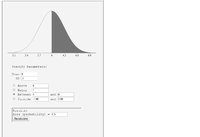Hello,
I'm new and trying to learn all things probability and have stumbled upon a 'Normal Distribution' question that asks -
Find the probability that an item with a Mean = 4cm, and Standard Deviation of = 0.3cm is going to fit into a space that requires items to be a size inbetween 4cm and 6cm.
I've worked out so far that -
4 - 4 / .3 = 0
and
6 - 4 / .3 = 6.666666666666667
But to my knowledge Z-Scores only tend to go up to plus or minus 3.9. Therefore how does the 6.67 fit into everything?
An online calculator says that the probability would equal 0.50 (50%) to fit into the space but I can't work out how that comes about unless you use the '4 - 4 / .3 = 0' equation which equals 0.50 on he Z-Score table.
Do you void the 6.67 value as it doens't register on the Z-Score table?
Any information wouild be usefuil andmuch appreciated as I can't seem to find anything putting me in the right direction.
* Also attached an image of the online calculators answer (if correct)
I'm new and trying to learn all things probability and have stumbled upon a 'Normal Distribution' question that asks -
Find the probability that an item with a Mean = 4cm, and Standard Deviation of = 0.3cm is going to fit into a space that requires items to be a size inbetween 4cm and 6cm.
I've worked out so far that -
4 - 4 / .3 = 0
and
6 - 4 / .3 = 6.666666666666667
But to my knowledge Z-Scores only tend to go up to plus or minus 3.9. Therefore how does the 6.67 fit into everything?
An online calculator says that the probability would equal 0.50 (50%) to fit into the space but I can't work out how that comes about unless you use the '4 - 4 / .3 = 0' equation which equals 0.50 on he Z-Score table.
Do you void the 6.67 value as it doens't register on the Z-Score table?
Any information wouild be usefuil andmuch appreciated as I can't seem to find anything putting me in the right direction.
* Also attached an image of the online calculators answer (if correct)

